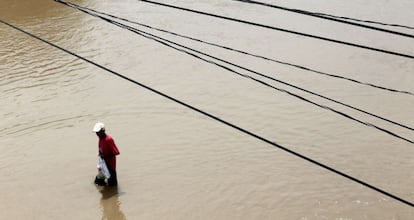In aftermath of deadly storms, Mexicans blame authorities for lack of preparation
Government officials claim they alerted six state governors about dangers Last month’s hurricane and tropical storm left 145 dead


Last month, Mexico was drenched with torrential rainfall from two storms, which flooded both the Pacific and Gulf coasts at the same time and caused major damage in several states. The death toll from Hurricane Ingrid and Tropical Storm Manuel stands at 145, while thousands of displaced Mexicans are still in shelters.
As the mud that buried entire towns and villages begins to dry, residents who lost their homes and other valuables have questioned whether Mexican authorities acted correctly in preparing them for the emergency.
Hardest hit was Guerrero state on Mexico’s Pacific coast, where evidence is now emerging that flaws in building construction and urban planning contributed to the disaster. Many are wondering whether the government was quick to respond and question the coordination between officials.
On Saturday, Miguel Ángel Osorio Chong, President Enrique Peña Nieto’s chief of staff, announced that the government will present hard evidence that demonstrates that local authorities were given ample warning about the dangers of the approaching storms.
Questions still remain as to whether those emergency warnings were filtered to local authorities
“We are going to give you [proof] that shows everything was done correctly, and then after we do so, the state governments and municipal authorities will have to demonstrate that they also followed through,” he said during an inspection of Coyuca de Catalán, a town in Guerrero.
The director of Mexico’s civil protection agency, Luis Felipe Puente, has come under fire for not acting swiftly enough. Last week, various lawmakers called for Puente to step down.
On September 11, the National Meteorological Service (SMN) issued its first bulletins warning of the incoming storms. But it wasn’t until four days later that the government called together the National Emergency Committee, by which time at least 14 people had already been reported dead and mudslides had cut off the only major highway connecting the resort of Acapulco to Mexico City.
“Ask all the state governors yourselves whether I was on the phone speaking to each one of them way before this occurred,” Osorio Chong told lawmakers last week. He claimed to have spoken to the governors of Veracuz, Guerrero, Tamaulipas, Oaxaca, Quintana Roo and Sinaloa, states that were badly hit by the remnants of the two storms.
Luis Walton, the president of the Acapulco City Council, said that no one had informed him of the magnitude of the impending storm.
Reports in various media outlets have concluded that Mexico isn’t adequately prepared to deal with emergencies caused by severe weather – an affirmation echoed by Guerrero Governor Ángel Aguirre in recent days.
On Sunday, the daily Milenio reported that none of Mexico’s 31 states has compiled a plan of action that outlines steps local authorities must take in 28 emergency scenarios, including earthquakes, chemical accidents, flooding and hurricanes.
Also compounding the problems is poor urban planning as the result of public corruption, where builders had been allowed to construct dwellings on unstable land.
President Peña Nieto, who canceled his trip to New York for the UN General Assembly meeting as well as a subsequent visit to Singapore, has called for a high-level investigation to determine why Guerrero state officials did not stop the rash of illegal constructions.
Tu suscripción se está usando en otro dispositivo
¿Quieres añadir otro usuario a tu suscripción?
Si continúas leyendo en este dispositivo, no se podrá leer en el otro.
FlechaTu suscripción se está usando en otro dispositivo y solo puedes acceder a EL PAÍS desde un dispositivo a la vez.
Si quieres compartir tu cuenta, cambia tu suscripción a la modalidad Premium, así podrás añadir otro usuario. Cada uno accederá con su propia cuenta de email, lo que os permitirá personalizar vuestra experiencia en EL PAÍS.
¿Tienes una suscripción de empresa? Accede aquí para contratar más cuentas.
En el caso de no saber quién está usando tu cuenta, te recomendamos cambiar tu contraseña aquí.
Si decides continuar compartiendo tu cuenta, este mensaje se mostrará en tu dispositivo y en el de la otra persona que está usando tu cuenta de forma indefinida, afectando a tu experiencia de lectura. Puedes consultar aquí los términos y condiciones de la suscripción digital.








































